
George Albert Smith was an English stage hypnotist, psychic, magic lantern lecturer, Fellow of the Royal Astronomical Society, inventor and a key member of the loose association of early film pioneers dubbed the Brighton School by French film historian Georges Sadoul. He is best known for his controversial work with Edmund Gurney at the Society for Psychical Research, his short films from 1897 to 1903, which pioneered film editing and close-ups, and his development of the first successful colour film process, Kinemacolor.

As Seen Through a Telescope is a 1900 British short silent comedy film, directed by George Albert Smith, featuring an elderly gentleman getting a glimpse of a woman's ankle through a telescope. The three-shot comedy, according to Michael Brooke of BFI Screenonline, "uses a similar technique to that which G.A. Smith pioneered in Grandma's Reading Glass (1900)," and, although "the editing is unsophisticated, the film does at least show a very early example of how to make use of point-of-view close-ups in the context of a coherent narrative ." "Smith's experiments with editing," Brooke concludes, "were ahead of most contemporary film-makers, and in retrospect it can clearly be seen that he was laying the foundations of film grammar as we now understand it."

The Kiss in the Tunnel, also known as A Kiss in the Tunnel, is a 1899 British short silent, comedy film, produced and directed by George Albert Smith, showing a couple sharing a brief kiss as their train passes through a tunnel, which is said to mark the beginnings of narrative editing. The film is the first to feature Laura Bayley, Smith's wife.
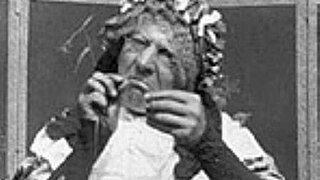
Grandma Threading her Needle is a 1900 British short silent comedy film, directed by George Albert Smith, featuring an old woman trying to get a thread though a needle. The sole purpose of the 56-second single-shot film, like the director's earlier Old Man Drinking a Glass of Beer (1898), according to Michael Brooke of BFI Screenonline, "is to record changing facial expressions for the purposes of entertainment."
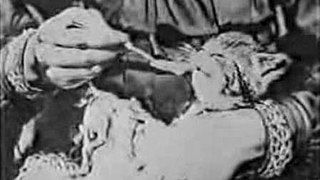
The Sick Kitten is a 1903 British short silent comedy film, directed by George Albert Smith, featuring two young children tending to a sick kitten.
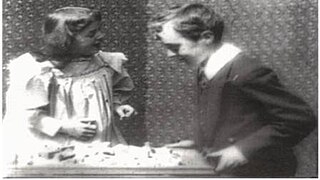
The House That Jack Built is a 1900 British short,silent trick film directed by George Albert Smith, featuring a boy who knocks over a house made of bricks built by his sister and then rebuilds it when the original sequence is shown in reverse. "In addition to exploiting a popular cinematic trick," of, "reversing the film in the projector," and, "its audience's presumed knowledge of the technique," the director, according to Michael Brooke of BFI Screenonline, "was continuing his experiments with narrative forms," with the reversed sequence, "interpreted as wish-fulfilment on the part of the girl, hoping that time will literally turn back on itself to allow her house to be rebuilt," he, "demonstrates that while this is impossible in reality, it is easily achievable in cinema."

Woman Draped in Patterned Handkerchiefs is a 1908 British short silent documentary film, directed by George Albert Smith as a showcase of his new Kinemacolor system, which features a woman displaying assorted tartan cloths, both draped on her body and waved semaphore-style. The patterned handkerchiefs are, according to Michael Brooke of BFI Screenonline, "presumably the same cloths featured in Tartans of Scottish Clans (1906), this time shown from various angles."

Santa Claus is an 1898 British silent trick film directed by George Albert Smith, which features Santa Claus visiting a house on Christmas Eve. The film, according to Michael Brooke of BFI Screenonline, "is believed to be the cinema's earliest known example of parallel action and, when coupled with double-exposure techniques that Smith had already demonstrated in the same year's The Mesmerist (1898) and Photographing a Ghost (1898), the result is one of the most visually and conceptually sophisticated British films made up to then." It has been described as the very first Christmas movie and a technical marvel of its time.

The Old Maid's Valentine is a 1900 British short silent comedy film, directed by George Albert Smith, which features the titular Miss Pimple receiving an unpleasant surprise on 14 February. The film, according to Michael Brooke of BFI Screenonline, "is essentially a facial - a medium close-up shot of a single performer whose changing expression constitutes virtually all the film's dramatic action." David Fisher points out that, "the flapping of the sheet of paper and the movement of the calendar betray the open-air set," which, "makes it difficult to read the message: Just like Mama," whilst, "the remarkably well-behaved cat," which, "sits patently licking its paws," "suggests that Smith may have already learned the trick of smearing the cat's fur with food."

The X-Rays is an 1897 British silent comic trick film directed by George Albert Smith, featuring a courting couple exposed to X-rays. The 44-second trick film, according to Michael Brooke of BFI Screenonline, "contains one of the first British examples of special effects created by means of jump cuts" Smith employs the jump-cut twice; first to transform his courting couple via "X rays," dramatized by means of the actors donning black bodysuits decorated with skeletons and with the woman holding only the metal support work of her umbrella, and then to return them and the umbrella to normal. The couple in question were played by Smith's wife Laura Bayley and Tom Green, a Brighton comedian.

Let Me Dream Again is a 1900 British short silent drama film, directed by George Albert Smith, featuring a man dreaming about an attractive young woman and then waking up next to his wife. The film stars Smith's real wife, Laura Bayley, as the woman of his fantasies. Bayley would later appear in Smith's 1906 film Mary Jane's Mishap. The film, according to Michael Brooke of BFI Screenonline, "is an excellent example of an early two-shot film, and is particularly interesting for the way it attempts a primitive dissolve by letting the first shot slip out of focus before cutting to the second shot, which starts off out of focus and gradually sharpens." This appears to be the first use of a dissolve transition to signify a movement of a dreaming state to one of reality.
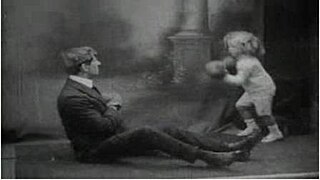
The Man to Beat Jack Johnson is a 1910 British short black-and-white silent comedy film, produced by the Tyler Film Company, featuring four-year-old Willy Sanders demonstrating his boxing and wrestling skills against an adult opponent.

The Biter Bit is an 1899 British short black-and-white silent comedy film, produced by Bamforth & Co Ltd, featuring a boy playing a practical joke on a gardener by grasping his hose to stop the water flow and then letting go when the gardener looks down it to check. The film "is an English remake" of Auguste and Louis Lumière's L'Arroseur Arrosé (1895), according to Michael Brooke of BFI Screenonline, "providing a good illustration of how early film production companies cheerfully plagiarised each other's work" with "a few minor differences between, most notably a rather greater sense of space and depth in the Bamforth version" and "three distinct planes to the action". It is included in the BFI DVD Early Cinema: Primitives and Pioneers and a clip is used in Paul Merton's interactive guide to early British silent comedy How They Laughed on the BFI website.

The Automatic Motorist is a 1911 British silent comic trick film, directed by Walter R. Booth, featuring a robot chauffeur taking an inventor and a young honeymooning couple on a wild ride around the planets and under the sea. The trick film is a "virtual remake of The '?' Motorist (1906)," according to Michael Brooke of BFI Screenonline, "but on a bigger scale."

Comic Costume Race is an 1896 British short black-and-white silent actuality film, directed by Robert W. Paul, featuring comic costume scramble at the Music Hall Sports on 14 July 1896 at Herne Hill, London. The music hall sports day was an annual charity event consisting of other events such as egg and spoon races and three-legged races. The film is the best surviving pictorial record of the Music Hall Sports. It is not known who the race participants are.

Tommy Atkins in the Park is an 1898 British short black-and-white silent comedy film, directed by Robert W. Paul, featuring a couple courting in a park who are forced to use desperate measures to get rid of a stout matron who interrupts them. The film was a remake of Alfred Moul's The Soldier's Courtship (1896). It is included on the BFI DVD R.W. Paul: The Collected Films 1895-1908 and a clip is featured in Paul Merton's interactive guide to early British silent comedy How They Laughed on the BFI website.

Willie's Magic Wand is a 1907 British silent comic trick film, directed by Walter R. Booth, featuring a young boy terrorising the household with his father's magic wand.

Robbery is an 1897 British short black-and-white silent comedy film directed by Robert W. Paul, featuring a wayfairer who is forced to hand over his valuables and some of his clothes to an armed robber. The film, "although only intended as a comedy," according to Michael Brooks of BFI Screenonline, "in fact reveals how the stripping of one's Victorian 'uniform' also meant the stripping of one's integrity," and, "turns the viewer into an accomplice, since it forces us to watch the man's humiliation head-on, ultimately aligning ourselves not with the victim but with the thief." It is included on the BFI DVD R.W. Paul: The Collected Films 1895-1908.
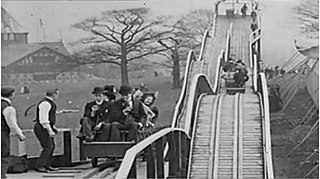
A Switchback Railway is an 1898 British short black-and-white silent actuality film, directed by Robert W. Paul, featuring patrons riding on a switchback railway at a fairground at Alexandra Palace, where Blandford Hall can be seen in the background. "This dynamically composed actuality," according to Michael Brooke of BFI Screenonline, "was clearly a success, so much so that James Williamson and the Riley Brothers released their own switchback railway films only a few months later." It is included on the BFI DVD R.W. Paul: The Collected Films 1895-1908. It is arguable that the filmmaker, R.W. Paul, missed a trick by not placing the camera inside one of the moving cars to simulate the ride from the passenger's perspective, although he might have had difficulty keeping the camera steady. Nonetheless, the film was clearly a success, so much so that James Williamson and the Riley Brothers released their own switchback railway films only a few months later.

Army Life; or, How Soldiers Are Made: Mounted Infantry is a 1900 British short black-and-white silent propaganda actuality film, directed by Robert W. Paul, featuring the King's Own Royal Lancaster Regiment riding over a plain. The film, which premiered on 18 September 1900 at the Alhambra Theatre in London, England, "is all that appears to remain of one of R.W. Paul's most ambitious projects," which, according to Micahael Brooke of BFI Screenonline, "had it survived in a more complete form," "would undoubtedly be considered one of the most important precursors of the modern documentary."




















